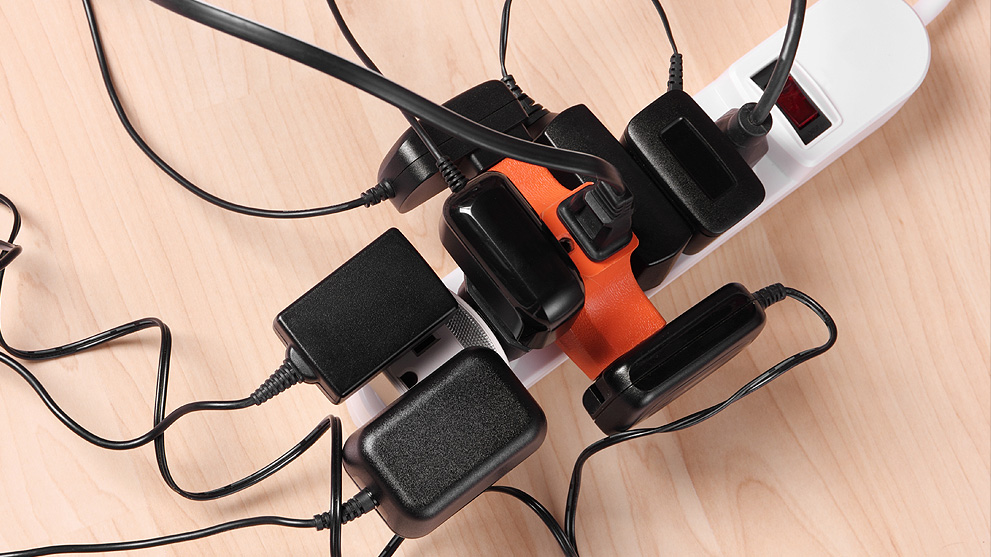Ignoring electrical safety instructions may put your safety and property at risk. Let’s all do our part to contribute to a safe and accident-free environment.
Outlets
Look for outlets that have loose-fitting plugs, exposed wires or broken plates. Have them fixed by a qualified electrician. Use safety covers on all outlets accessible to children.
Cords
Do not place appliance cords where they will come into contact with the stove or other heated surfaces. Do not hang appliance cords over countertops, where they might be accidentally pulled down.
Frayed Appliance Cords
Worn or frayed appliance cords can cause fire, electric shock and even electrocution. As a basic home safety procedure, inspect cords regularly to assess wear and replace cords as needed.
Surge Protectors
Only use surge protectors with internal circuit breakers. To prevent overheating, these units will trip the breaker if the power strip is overloaded or shorted to prevent overheating. Do not plug a surge protector into an existing surge protector. When the surge protector is not in use, unplug the unit.
Shoes
Avoid damp or wet areas when using electrical power tools outdoors. Wear sturdy, rubber-soled shoes when working with electrical appliances outdoors. Never use electrical equipment when barefoot.
Ladders
Exercise caution when using ladders, painting, pruning or cleaning near a service drop — where the wiring comes into a house or building at the meter. Weatherproofing on the overhead wiring is not insulation. This covering can become brittle and cracked, exposing you to electrical contact.
Space Heaters
Read all manufacturer's instructions before use, and keep heaters away from furniture, curtains, sinks, tubs and water. Do not lay rugs or carpet over the cord. Do not use the heater if the cord is frayed or broken, and do not use an extension cord. Turn off the heater before leaving home or going to bed.
Swimming Pools
Do not use electrical appliances near pools or route extension cords in the vicinity of pools. Do not raise pool maintenance or rescue poles into overhead power lines.
Boats
Keep boat masts away from power lines.
Trees
Do not climb trees near power lines. Keep balloons, kites, fishing lines and aluminum poles away from overhead lines. The lines are not insulated and you could create a path to the ground by touching them.
Utility Poles
Do not swing, climb or run into guy wires supporting utility poles. Report damaged guy wires to Georgia Power.
Meter Boxes
Ensure safe and easy access to your meter box—do not fence in meter boxes, use private locks on meter boxes, or surround meter boxes with trees and shrubs. Keep dogs safely secured away from your meter box.
Home Appliance Amp Reference Chart
To determine the amount of wattage a branch circuit can handle, multiply the circuit's amperage by the circuit's volts. A 20-amp, 120-volt circuit can handle 2,400 watts.
The following list gives you the average wattage rating for common household equipment. For specific information on your home equipment, check the manufacturer's listing found in your owner's manual or on the information plate of the equipment. For lighting, check the wattage rating of the bulbs being used.
How many appliances can a particular circuit handle?
To determine how many watts a branch circuit can handle, you need to know two things:
- First, how many amperes, or amps, for which a circuit is rated. An amp is the amount of electrical current that flows through a circuit. In most homes, lighting and small appliance circuits are 15 or 20 amps, and major appliances are on 20, 50 or even 60 amp circuits.
- Second, the volts flowing through the wires. Volts are a measure of the pressure that causes current to flow through a circuit. Generally, household wiring is 120 or 240 volts.
| Major Appliances Approximate Wattage | |
|---|---|
| Equipment | Approximate Wattage |
| Baseboard Heater | 1,600 |
| Clothes Dryer | 4,900 |
| Dishwasher | 1,200 |
| Frost-Free Deep Freeze | 500 |
| Frost-Free Refrigerator | 615 |
| Furnace | 500 |
| Garbage Disposal | 450 to 950 |
| Oven | 4,000 to 8,000 |
| Range | 4,000 to 5,000 |
| Room Heater | 1,350 |
| Standard Deep Freeze | 400 |
| Standard Refrigerator | 325 |
| Washing Machine | 500 |
| Water Heater | 2,000 to 5,000 |
| Small Appliances Approximate Wattage | |
|---|---|
| Equipment | Approximate Wattage |
| Blender | 300 |
| Box Fan | 175 |
| Clock Radio | 70 |
| Coffee Maker | 1,200 |
| Food Processor | 200 |
| Hair Dryer | 600 |
| Heating Blanket | 200 |
| Heating Pad | 65 |
| Iron | 1,100 |
| Microwave Oven | 1,450 |
| Mixer | 130 |
| Sewing Machine | 75 |
| Toaster | 1,150 |
| Toaster / Toaster Oven | 1,150 |
| Two Burner Hot Plate | 1,650 |
| Vacuum Cleaner | 750 to 1,350 |
| Electronics Approximate Wattage | |
|---|---|
| Equipment | Approximate Wattage |
| Computer | 300 |
| Stereo | 1,200 |
| Television | 150 |
| Power Tools Approximate Wattage | |
|---|---|
| Equipment | Approximate Wattage |
| Circular Saw | 1,200 |
| Drill Press | 1,100 |
| Power Drill | 350 |
| Table Saw | 4,500 |
| Wet / Dry Vacuum | 1,850 |

